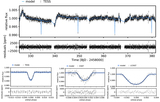A Highly Eccentric Warm Jupiter Orbiting TIC 237913194
Abstract
The orbital parameters of warm Jupiters serve as a record of their formation history, providing constraints on formation scenarios for giant planets on close and intermediate orbits. Here, we report the discovery of TIC 237913194b, detected in full-frame images from Sectors 1 and 2 of the Transiting Exoplanet Survey Satellite (TESS), ground-based photometry (Chilean-Hungarian Automated Telescope, Las Cumbres Observatory Global Telescope), and Fiber-fed Extended Range Optical Spectrograph radial velocity time series. We constrain its mass to ${M}_{P}$ = ${1.942}_{-0.091}^{+0.091}$ ${M}_{J}$ and its radius to ${R}_{{\rm{P}}}$ = ${1.117}_{-0.047}^{+0.054}$ ${R}_{J}$ , implying a bulk density similar to Neptune's. It orbits a G-type star ( ${M}_{\star }$ = ${1.026}_{-0.055}^{+0.057}$ ${M}_{\odot }$ , V = 12.1 mag) with a period of 15.17 days on one of the most eccentric orbits of all known warm giants (e ≈ 0.58). This extreme dynamical state points to a past interaction with an additional, undetected massive companion. A tidal evolution analysis showed a large tidal dissipation timescale, suggesting that the planet is not a progenitor for a hot Jupiter caught during its high-eccentricity migration. TIC 237913194b further represents an attractive opportunity to study the energy deposition and redistribution in the atmosphere of a warm Jupiter with high eccentricity.
- Publication:
-
The Astronomical Journal
- Pub Date:
- December 2020
- DOI:
- 10.3847/1538-3881/abbe03
- arXiv:
- arXiv:2010.03570
- Bibcode:
- 2020AJ....160..275S
- Keywords:
-
- Exoplanet astronomy;
- Transit photometry;
- Radial velocity;
- Exoplanet dynamics;
- Exoplanet atmospheres;
- Exoplanet structure;
- Hot Jupiters;
- Extrasolar gas giants;
- 486;
- 1709;
- 1332;
- 490;
- 487;
- 495;
- 753;
- 509;
- Astrophysics - Earth and Planetary Astrophysics
- E-Print:
- 20 pages, 14 figures. Accepted for publication in AJ
